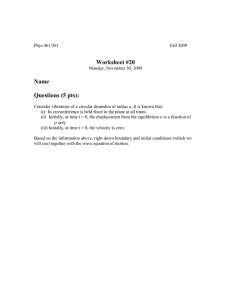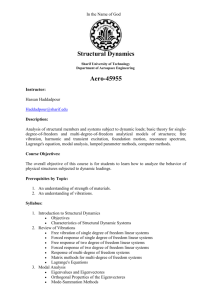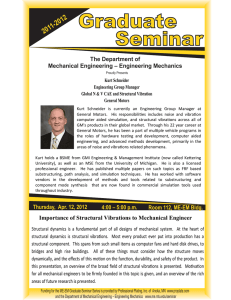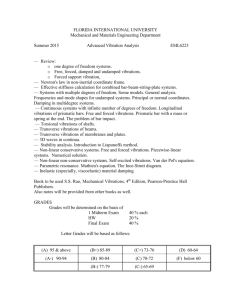MECH 5500 - Carleton University
advertisement
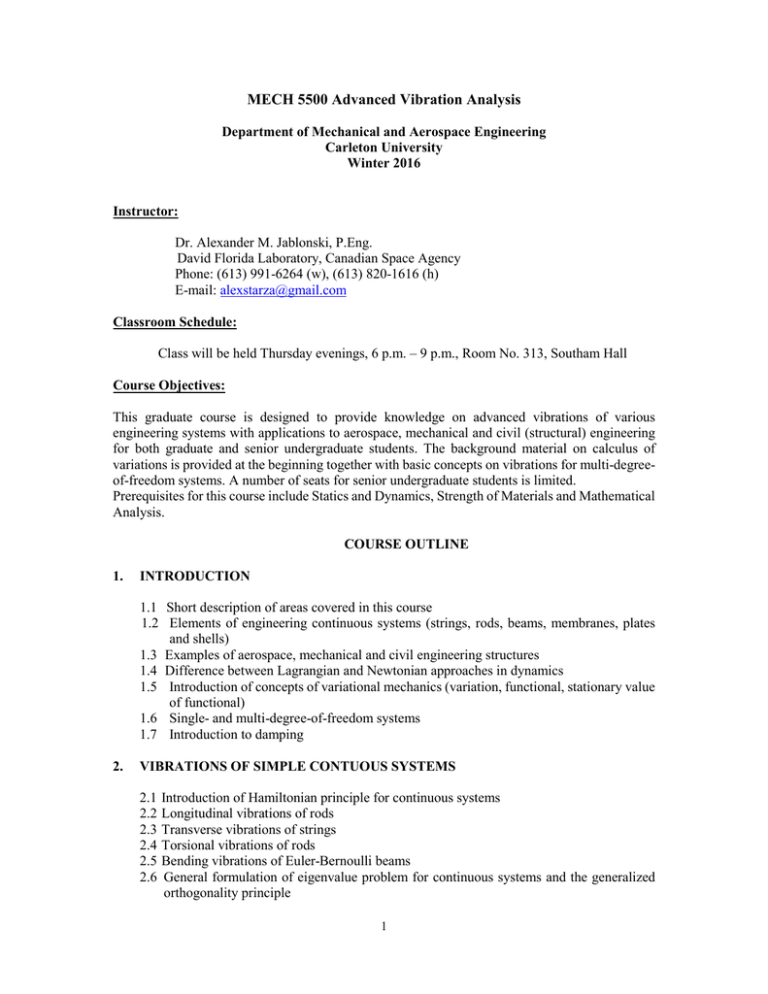
MECH 5500 Advanced Vibration Analysis Department of Mechanical and Aerospace Engineering Carleton University Winter 2016 Instructor: Dr. Alexander M. Jablonski, P.Eng. David Florida Laboratory, Canadian Space Agency Phone: (613) 991-6264 (w), (613) 820-1616 (h) E-mail: alexstarza@gmail.com Classroom Schedule: Class will be held Thursday evenings, 6 p.m. – 9 p.m., Room No. 313, Southam Hall Course Objectives: This graduate course is designed to provide knowledge on advanced vibrations of various engineering systems with applications to aerospace, mechanical and civil (structural) engineering for both graduate and senior undergraduate students. The background material on calculus of variations is provided at the beginning together with basic concepts on vibrations for multi-degreeof-freedom systems. A number of seats for senior undergraduate students is limited. Prerequisites for this course include Statics and Dynamics, Strength of Materials and Mathematical Analysis. COURSE OUTLINE 1. INTRODUCTION 1.1 Short description of areas covered in this course 1.2 Elements of engineering continuous systems (strings, rods, beams, membranes, plates and shells) 1.3 Examples of aerospace, mechanical and civil engineering structures 1.4 Difference between Lagrangian and Newtonian approaches in dynamics 1.5 Introduction of concepts of variational mechanics (variation, functional, stationary value of functional) 1.6 Single- and multi-degree-of-freedom systems 1.7 Introduction to damping 2. VIBRATIONS OF SIMPLE CONTUOUS SYSTEMS 2.1 2.2 2.3 2.4 2.5 2.6 Introduction of Hamiltonian principle for continuous systems Longitudinal vibrations of rods Transverse vibrations of strings Torsional vibrations of rods Bending vibrations of Euler-Bernoulli beams General formulation of eigenvalue problem for continuous systems and the generalized orthogonality principle 1 3. VIBRATIONS OF COMPLEX CONTINUOUS SYSTEMS 3.1 3.2 3.3 3.4 4. Vibrations of Timoshenko beams Vibrations of rectangular and circular membranes Transverse vibrations of rectangular and circular plates Introduction to vibrations of circular cylindrical shells DISCRETIZATION PROCEDURES 4.1 4.2 4.3 4.4 Rayleigh quotient, Rayleigh energy method Ryleigh-Ritz method, assumed modes method Weighted residuals method; Galerkin method; collocation method Application of Finite Element Method (FEM) to vibration problems 5. INTRODUCTION TO FORCED VIBRATION ANALYSIS 5.1 Unit Step Response (USR) and Unit Impulse Response (UIR) of the Simple Harmonic Oscillator 5.2 Response to arbitrary excitation of the SHO 5.3 Force undamped vibrations of the discrete systems – general formulation 5.4 Integral formulation of the Equations of Motion (EOM) 5.5 Forced vibrations of continuous system – general formulation 6. COMMENTS ON NONLINEAR VIBRATIONS 6.1 6.2 6.3 6.4 6.5 General comments Phase plane Conservative systems Stability of equilibrium Methods of solution (perturbation method, method of iteration) 7. INTRODUCTION TO MODAL ANALYSIS 7.1 7.2 7.3 7.4 Short overview of modal analysis Simple example of modal analysis Applications of modal analysis Visit to David Florida Laboratory in the CSA – optional 8. SPECIAL PROBLEMS AND APPLICATIONS (can be changed) 8.1 8.2 8.3 8.4 8.5 Stability of slender beams subjected to axial load Effects of damping Vibrations of foundations for machinery Dynamic modeling of flexible spacecraft Introduction to random vibrations 2 Lecture Notes (to be presented during lectures) Lecture notes will cover all materials. Reference book list is also provided at the end of this outline. These can be used as supplementary reading/problem-solving materials for the course. Assignments Problems will be assigned through the course in the form of 5-6 assignments. Solutions for the assignments will be made available later on. Additional assignments can be considered. Project Students will make a choice from the list of possible projects. This project will include a literature search, solution on the problem and the presentation of the report (including a presentation during class) Exams Final 3 hours (lecture notes and calculator only, no example problems or assignments will be permitted). Marking Scheme 6 Assignments Project Final Examination Total 30% 30% 40% 100% References (can be modified later) A. Shabana , “Vibrations of Discrete and Continuous Systems”, Second Edition, Springer Verlag, 1997 (textbook) L. Meirovitch, “Principles and Techniques of Vibrations”, Prentice Hall, 1997 W.C. Hurty and M. F. Rubinstein, “Dynamics of Structures” J.L. Humar, “Dynamics of Structures”, Tylor and Francis, 2005 A.H. Nayhef and D.T. Mook, “Nonlinear Oscillations”, J.Wiley, 1995. Academic Integrity Statement for Graduate Course Outlines: Plagiarism and cheating at the graduate level are viewed as being particularly serious and the sanctions imposed are accordingly severe. Students are expected to familiarize themselves with and follow the Carleton University Student Academic Integrity Policy (See http://www2.carleton.ca/graduate-studies/policies-and-guidelines). The Policy is strictly enforced and is binding on all students. Plagiarism and cheating – presenting another’s ideas, arguments, words or images as your own, using unauthorized material, misrepresentation, fabricating or misrepresenting research data, unauthorized co-operation or collaboration or completing work for another student – weaken the quality of the graduate degree. Academic dishonesty in any form will not be tolerated. Students who infringe the Policy may be subject to one of several penalties including: expulsion; suspension from all studies at Carleton; suspension from full-time studies; a refusal of permission to continue or to register in a specific degree program; academic probation; or a grade of Failure in the course. 3
